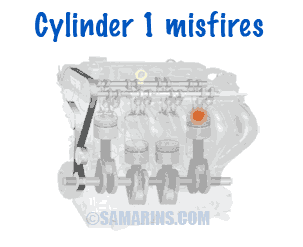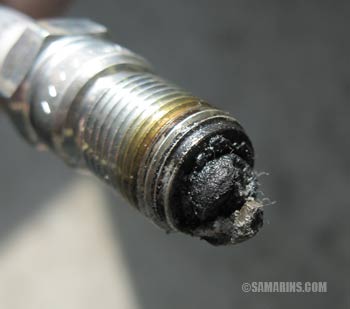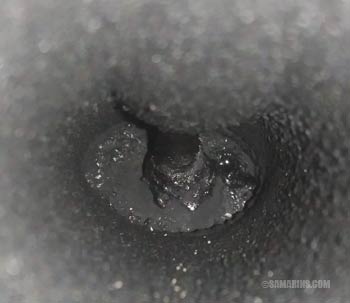How Can Engine In Cylinder Head Be Repaired If Cracked
P0300-P0308 Cylinder Misfire Detected. Causes, common bug, diagnostic
Updated: July 17, 2022
The lawmaking P030X (p0301-P0308) means that the cylinder number X misfires, or there is no combustion in that cylinder. For example, if the cylinder number ane misfires in a 4-cylinder engine, it will run only on 3 cylinders and will have the code P0301, see the animation.
 Misfiring engine.
Misfiring engine.
The code P0300 stands for random misfire. This means that multiple cylinders misfire at random.
Can y'all drive with the code P0300-P0308? Driving with a misfiring engine can crusade more damage. When a cylinder misfires, unburned gasoline can overheat and melt the catalytic converter, which is an expensive part of the emission control arrangement.
Some manufacturers advise not to bulldoze with a misfiring engine; others recommend driving only in a very moderate fashion and having your vehicle checked out as soon as possible. Run into the vehicle's owner's manual for details.
Symptoms:
A misfiring engine shakes, runs crude (unevenly) and lacks power. Shaking is more noticeable at idle or during acceleration. Some cars misfire only when started cold. The "Bank check Engine" calorie-free on the dash may blink repeatedly or stay on solid. Sometimes, you could also notice a different scent from the exhaust. Watch this video of a misfiring engine.
Causes:
The most common crusade of the engine misfire and the codes P030X in modern cars is a failed on-plug ignition curl. Other causes include:
 Fouled spark plug
Fouled spark plug  Carbon buildup on an intake valve
Carbon buildup on an intake valve
- Worn-out, cracked or fouled (in the photo) spark plugs.
- Faulty fuel injectors
- Damaged or cracked ignition curlicue pack.
- Damaged ignition scroll master circuit wires (frequently chewed by critters).
- Cracked or damaged spark plug cables.
- Carbon build up on valves and injectors (common in engines with Straight Injection)
- Vacuum leaks. A vacuum leak volition cause misfire in the cylinder closest to the source of the leak. Examples of vacuum leaks include: leaking intake manifold gasket, broken PCV valve or PCV hose, disconnected vacuum line, cracked vacuum line
- Leaking head gasket
- Low compression in the affected cylinder
- Bug with the valvetrain components
- Bad engine figurer (PCM)
What tin can cause the code P0300 - Random cylinder misfire:
If the code P0300 occurs with other codes, such as, for example, P0171, P0101, P0102, P0420, P0401, the additional codes must be diagnosed first, every bit the random cylinder misfire ofttimes happens as a consequence of other problems. Possible causes include:
- Bad mass airflow sensor.
- Ripped intake air snorkel
- Stuck-open up EGR valve or purge valve (solenoid)
- Worn valvetrain components
- Depression fuel pressure
- Improperly set up valve timing
- Clogged catalytic converter
- Problems with the crankshaft position sensor (CKP) or camshaft position sensor (CMP)
How misfiring is diagnosed
The cause of misfire of one of the cylinders should be fairly piece of cake to pinpoint if the problem is present at the time of checking. For instance, mechanics can identify a faulty on-plug ignition curlicue by swapping the coils between the cylinders and checking if the misfire moved with the ringlet or stayed at the aforementioned cylinder. The same process can be used to identify a bad fuel injector.
A quick look at the spark plugs can tell a lot. Signs of arcing on the ignition ringlet likewise betoken to the faulty role. An important step is to check for related service bulletins issued past the car manufacturer. If you don't have access to the factory repair manual, Google 'Make Model Year service bulletin code P0301'. See a few examples below. Basics such as compression, timing and fuel pressure level will besides need to be checked if no obvious error is found.
The engine might need to exist checked for vacuum leaks. Read more than: Vacuum leaks: common sources, symptoms, repairs. The brusk term fuel trim (STFT) and long term fuel trim (LTFT) need to be checked with a browse tool to see if the air/fuel mixture is not too lean. Oft a bad mass air flow sensor causes the engine to run lean causing random misfire. Read more than almost STFT and LTFT fuel trims here.
Pressure-testing the cooling system might help place a leaking caput gasket that tin can as well crusade misfiring. A low coolant level and white smoke can as well point to a leaking head gasket.
Valve adjustment may need to be checked, as valves that are out of aligning tin can crusade misfiring at a cold start, which is, for example, a common issue in some older Honda engines.
If misfiring happens only at idle, the EGR valve and purge valve need to be checked, equally either ane could exist stuck open.
Faulty valve train components such as worn camshaft lobes, collapsed lifters, bad rocker arms or stretched timing concatenation can also cause the engine to misfire.
Sometimes a broken or damaged molar at the crankshaft or camshaft sensor gear can be the source of misfiring. This tin be checked by monitoring the crankshaft position sensor (CKP) or camshaft position sensor (CMP) signal with an oscilloscope; read more hither.
Once the problem is repaired or no longer detected, the misfiring code volition articulate itself afterwards some driving.
Common problems causing misfire codes P0300-P0308:
Failed on-plug ignition coils are common in many cars, including BMW, Ford, Hyundai, Mazda, Nissan, Toyota, Volkswagen and GM. A failed ignition scroll must be replaced; in a four-cylinder engine it's a fairly uncomplicated job. If spark plugs haven't been replaced in a while, information technology's a proficient thought to supplant all the spark plugs as well. Worn-out spark plugs require higher voltage to produce the spark, which adds strain on ignition coils.
Some automobile manufacturers update ignition coils during afterwards product. If 1 of the ignition coils has failed and the manufacturer has updated the part, your mechanic may recommend replacing other ignition coils with updated parts as a precaution.
In many mod cars, specially those with Directly Fuel Injection, carbon buildup on intake valves and the injector nozzle can cause misfiring. Some mechanics may recommend cleaning the valves with a special spray or foam (fuel induction service), as it's less expensive and sometimes helps. The more than effective selection is to clean the intake valves manually. Read more well-nigh carbon buildup on intake valves in this article. Chock-full fuel injectors demand to be replaced besides. This repair is costly, as it involves more labor; the intake manifold and some other parts will have to exist removed. Nosotros constitute a number of YouTube videos on the subject.
Vacuum leaks, as well as a stuck-open EGR valve or purge valve (solenoid) can cause misfiring that generally happens at idle, merely goes away at college rpms. Read more than: Vacuum leaks: mutual sources, symptoms, repairs.
In some older Honda vehicles misfiring tin can be caused past valves being out of aligning. Misfiring could be more noticeable when the engine idles afterward a cold outset. Equally the valve train components habiliment, the valve gaps change; to compensate, the valves in many Honda engines need to be adjusted at recommended intervals.
Sometimes, the engine could misfire if during the timing chugalug or chain replacement, the timing hasn't been set properly. If the trouble started after replacing a timing belt or chain, checking the timing is the first affair to practice.
In many high-mileage cars, oil leaking into a combustion chamber from worn valve seals and oil rings can foul spark plugs causing misfire; often an engine misfires at idle, only runs better after revving up.
In many older cars, washing the engine compartment or driving through deep puddles tin can cause the engine to misfire, as h2o gets into the ignition components and shorts them out. A tune-upwards with new spark plugs and spark plug cables often fixes the problem. On-plug ignition coils that show cracks or signs of arcing need to be replaced too. In older cars with a distributor ignition, a benefactor cap and rotor are also replaced equally part of the tune-up.
Examples of related service bulletins
The Honda service bulletin nineteen-038 for the 2022-2018 Honda Borough with a i.5L engine describes a problem where codes P0300-P0304 or P0172 (fuel system too rich) or a whirling noise coming from the engine tin be acquired either by fouled spark plugs or by irregular clothing of camshaft lobes. Bulletin 19-032 describes similar problem for the 2022-2018 Honda CR-V.
According to the Hyundai service message xx-FL-001H for the 2022 Elantra with a 2.0L engine, codes P0300/P0301/P0302/P0303/P0304 tin can be caused a faulty ignition coil. The solution per the bulletin is to inspect ignition coils and, if needed, supplant with an updated part and update the ECM software.
Toyota issued service bulletin T-SB-0148-19 for the 2022-2019 Highlander HV that mentions replacing the ignition coil and reprogramming the ECM as possible solutions (depending on diagnostics) for the codes P0301-P0306.
Mazda service bulletin 01-014/16 for the 2022-2016 CX-5, 2022-2016 Mazda 3 and Mazda 6 mentions the issue where an ignition coil tin can fail and cause codes P0301 to P0304. If confirmed, the defective roll must be replaced with an updated part.
How the code P0301 is set
The engine computer or PCM can detect a misfiring cylinder by monitoring the engine crankshaft speed (RPMs). If one of the cylinders misfires, the crankshaft loses momentum and slows downwardly in that moment. If the PCM detects a cylinder to misfire for a predetermined fourth dimension, it sets the code for the afflicted cylinder and turns the Check Engine low-cal on.
Can a tune-up set a misfire?
 Tune-up parts
Tune-up parts
The term 'tune-up' usually means changing spark plugs, replacing the air filter, possibly cleaning the throttle trunk as well as fuel injectors. In older cars, ignition wires, distributor cap, rotor, and a fuel filter are replaced too. Modernistic cars require melody-ups less frequently, equally they don't have ignition wires and use long-lasting spark plugs.
A tune-up is a function of preventative maintenance. To fix the misfire the verbal crusade must be diagnosed get-go. A tune upward needs to be done every sixty,000-lxxx,000 miles. It's best to use only OEM spark plugs.
How Can Engine In Cylinder Head Be Repaired If Cracked,
Source: https://www.samarins.com/diagnose/p0301.html
Posted by: blackwastain.blogspot.com


0 Response to "How Can Engine In Cylinder Head Be Repaired If Cracked"
Post a Comment